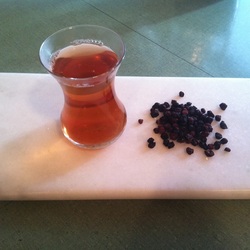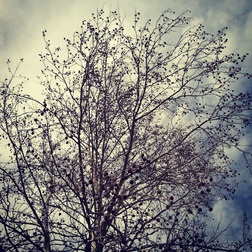 Schisandra (Schisandra chinensis) is a somewhat obscure herb that many people have never heard of before. Although it is indeed a relative newcomer to the Western herbalist’s pharmacopeia, it has been known, used, and loved by traditional Chinese herbal practitioners for thousands of years. A native of Asia, schisandra is a woody vine that produces bright red fruits at the end of summer; these fruits are then harvested and utilized for their extensive medicinal properties. But before we get into the medicinal uses of the unique schisandra berry, let’s talk about its taste… As I write this I am chewing on several dried berries and it’s as if a thousand sour fireworks went off in my mouth. Whew! To say that this plant is extremely flavorful is an understatement! I can taste the acutely sour and bitter notes as well as a peppery pungent taste. Chinese practitioners call it wu wei zi or “fruit of five flavors”, noting that schisandra incorporates all of the five tastes (sour, salty, bitter, sweet and pungent). Because of this distinctive quality it was thought to be an especially important tonic medicine. In classes I always remind my herbal students that a good way to become better acquainted with a new herb is to tune into its taste. Although we may not realize this simple fact, our taste buds can actually give us a lot of important information about a plant, i.e., how potent it is and how it could make us feel. Schisandra is a great example of how our tongue can give us clues about a plant’s medicinal action in the body. For instance, when I taste a few dried schisandra berries I immediately feel more awake and invigorated. The intense and sour taste is incredibly stimulating to my tongue (and, for lack of a better word, is very zing-y). It also clears away all other tastes and leaves my palate feeling cleansed. You can imagine that if this tart, little berry has such an invigorating and clearing effect on the tissues of the tongue, that it might have a very similar action on the rest of the body’s tissues and organs… Which indeed it does, according to traditional Chinese medicine where schisandra has been an important tonic herb for centuries – used to prolong life, slow the aging process, and increase stamina and energy levels. It was also believed that when used consistently over time, schisandra berry would cause one’s physical appearance to remain youthful. Scientific studies have validated the age-old regard for this plant, confirming that schisandra can help to reduce fatigue and also support mental concentration. Try chewing on a few dried berries or drinking the tea when you need to study for long periods of time or do focused work. The taste stimulates the mind and helps to keep your concentration steady and focused. Schisandra is also what we would call an adaptogenic herb, meaning that it helps to reduce mental and physical stress, increase energy, and enhance physical performance when taken over time. Not surprisingly, these qualities make it a great herb for athletes as it helps to increase endurance. However, even if you aren’t an athlete but want to improve your overall energy levels, schisandra can be beneficial. Even better, like many deeply colored berries, schisandra contains many protective antioxidants that help to maintain healthy cells throughout the body and reduce inflammation. Finally, another wonderful virtue of this plant is that it supports the liver. Schisandra is a hepatoprotective (liver-protecting) herb. It also exerts a gentle detoxifying action – remember how it makes your palate feel refreshed and cleansed? It has this same purifying effect for the liver, too. How to Use Schisandra: · To make schisandra berry tea at home, simmer 1 to 2 Tblsp. of the dried berries in 2 cups of water in a small, covered saucepan for 15 to 20 minutes. This will yield a much more medicinal and flavorful cup of tea than simply pouring boiled water over the herb. · Try using schisandra tea as an unconventional, but very effective, coffee alternative for an early morning jumpstart, or a caffeine-free energy boost in the afternoon. · Schisandra blends well with other herbal fruits such as hawthorn, elderberry and rosehips. You can also try substituting schisandra berry in any tea blend that would call for hibiscus. · Schisandra is also readily available in tincture form, which is convenient when you aren’t able to make a cup of tea. · Or, just chew on a few dried berries to reap schisandra’s benefits: start with one or two and work your way up. This article was originally posted on Cambridge Natural's blog.  Being from down south, I didn't grow up with a "real" winter season. Oh, we definitely pulled out the sweaters and coats (sometimes even hats and mittens) but for us southerners, it was a big deal if we got a few snow flurries in January. "Cold" was defined as anything below 60 degrees. So upon moving to New England I got to experience intense winter for the first time, and despite my southern background, it has become one of my favorite seasons. Although I certainly miss the greenness of the plants, trees and flowers, it is a time I have come to look forward to -- for there is beauty in every season, even bare winter. Like most things, however, you need to know how to make the most of snowy/cold/dark days. For me this means remembering and engaging the power of our senses. During winter months many of us notice that our senses can feel deprived -- it is darker, colder, and less colorful outside -- with fewer natural scents and sights to take in. We spend a lot more time indoors, and perhaps too much time front of a computer screen and in artificial light. By the end of winter, we may find ourselves feeling a bit low, and deeply longing for the sunshine, natural colors, and earthy scents that spring brings. So instead of begrudging winter for the season it is, start engaging your senses to make the most of this time. Below are some of my favorite and simple ways to feel more alive and vigorous during this special season: ✶ Surround yourself with indoor plants. Try forcing some bulbs, like paperwhites or colorful amaryllis. I bring my potted rosemary plants indoors and use them as festive decorations. I also use plants that I harvested and dried over the summer and make them into wreaths or unusual flower arrangements. ✶ Make daily infusions of uplifting and aromatic tea blends. Brew your favorite tea by the cup or by the pot-full and make it a small daily ritual. There are many excellent herbs to choose from for aromatic purposes. Some of my favorites include tulsi, lemon balm, ginger, spearmint, chamomile, rose petals and cinnamon. I also like to brew up my root chai on the stove so that the whole house smells like cardamom, pepper and clove. ✶ Use your favorite essential oil in a candle diffuser or in a bath. Lovely & uplifting ones for this time of year include cardamom, rosemary, tulsi (holy basil), and any citrus oil, such as sweet orange, grapefruit or bergamot. Citrus oils are especially beneficial for low spirits and the winter blues. ✶ Bring natural light indoors with candles. There is something incredibly soothing about candlelight, and gazing into the flame, especially in mid-winter. I favor beeswax candles for their long burn-time and sweet natural scent, but any kind of candle will do. Lighting candles is simple way to automatically transform your home and increase the cozy factor. ✶ Take a brisk walk outside. Even with temperatures in the teens it is good to get outside and get some sunlight on our skin. Bundle up, take a nice jaunt around the neighborhood, breathe in the cold air and notice the unique quality of the winter light at this time. Have a hot cup of aromatic tea awaiting you when you return. |
Categories
All
Archives
January 2022
|



